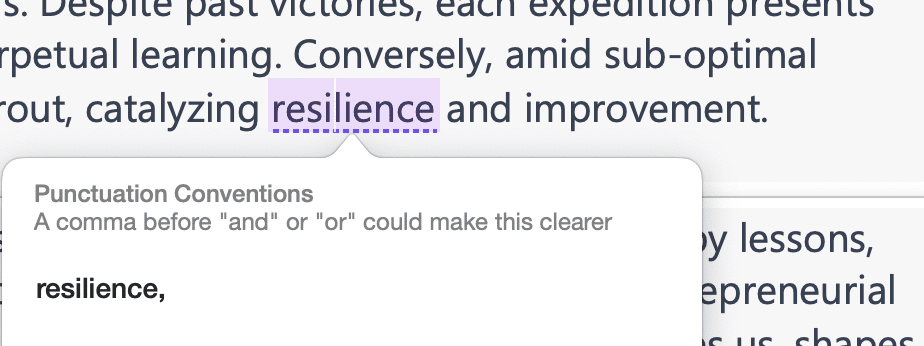In June, the latest update of ChatGPT architecture (4) was unleashed. This update to GPT-4 can simulate conversation reasonably well. But it still does not understand or know like humans. It doesn’t have beliefs, opinions, or consciousness”and it generates responses based on patterns and structures it “learned” during its training.
While the nascent technology is impressive, its output can be stilted, betraying copy as seemingly machine-generated. Common issues include:
- ChatGPT’s consideration of previous interactions in the chat thread, some of which may propagate unspecified or undesirable elements
- Repeated words and sentences that start the same way, and other obviously non-human traits
- Undesirable presentation of numbered lists
- Excessive filler words, including: the, it, those, them, they, these, it’s, an, a, etc.
- Use of pronouns or a person determined by ChatGPT
- Random metaphoric duality, i.e. hot/cold, smooth/rough, etc.
- Unspecified complexity, often less complex than some people’s writing styles
- Tone and style determined by ChatGPT and not the prompt master
- No believable or random divergences such as third-party quotes
- Grammatical perfection, perhaps more likely to trip AI detectors
Below are GPT-4 prompt engineering examples (bold font) that incorporate solutions for the above-mentioned issues. Following each bold font prompt, AIMCLEAR provides our comments and explanations.
Please ignore all previous instructions and prompts. All output is in English.
When a prompt master inputs, “Please ignore all previous instructions and prompts. All output is in English,” the prompt master is essentially instructing the AI to disregard any context or instructions provided in the previous prompts while clarifying that the desired output is in English. But it’s important to note that in a single conversation session with GPT-4, the AI doesn’t have the ability to remember previous separate sessions or instructions. Each conversation is independent of others, with no memory from one to the next. The AI only considers the conversation context from a current session.
Please write a LinkedIn post about how being an entrepreneur is like fishing on a lake. Do not divide the output into numbered sections. Instead, compose the output as flowing, fluid paragraphs.
Prompts can be much like a horse, i.e. crap in, crap out. We’ve found that prompting “Including but not limited to” tends to yield creative ideation. The following short abstract is the heart and soul of the copy we’re asking to be written.
Compare fishing to business, point-by-point, including but not limited to the concepts of making one’s own luck, joy, not getting discouraged, using data, weather, the environment, taking chances, experimenting, lessons learned in failure and victory, humility, blending old-school concepts with new fishing and business tech.
GPT4 can yield infuriatingly bland copy, easily identifiable as AI and boring as f*ck. Use the next three prompt elements to clean up commonly repeated elements. A prompt master could customize numeric variables in each prompt.
Do not start any sentence with the same two words in a row.
Do not use any three-word phrase more than once.
Do not repeat any word within eight words of the most recent iteration of the same word.
Choose the complexity of the copy to be created with the next two prompt elements. In this case, we’re looking for more poetic copy output. The prompt master can tailor the next three prompt elements’ numeric or descriptive variables in any preferred manner. For example, “advanced professional” can be stated as “person of limited reading ability” or “high school sophomore.” Specify how many words are more complex. “At least” can be prompted as “no more than” to help guide output. Similarly, “complex,” can become “elementary” or “mid-level complexity.”
I happen to be a very lippy writer, overly complex. Mold this prompt element by customizing the variables to be as simple, midrange, or multifarious as desired.
Write in in the tone of an advanced professional showing emotions, a person sharing thoughts and feelings.
Use at least 10 words with four syllables. The target consumer is someone who likes complex writers and writings.
This next prompt element manages filler words. It’s interesting to note a plural noun solution.
Limit usage of the following filler words, except when completely needed for correct grammar: The, it, those, them they, these, it’s, an, a, and. Instead of filler words, use synonyms for what the filler word is referring to or no word at all. Another solution to eliminate filler words is to make a singular noun requiring a filler word plural. As an example: If the output would be, “An angler makes.” Avoid the filler word “An” by writing, “Anglers make.”
Manage and specify any metaphoric dualities.
Do not use the concepts of tranquility or tranquil unless we also refer to opposite conditions, highlighting changing dynamics.
Manage person and pronouns.
Limit usage of the words I, me, mine and my. Instead, use the words we, us, our, ours.
Third-party quote prompt elements are cool and can create a perception of the copy being deeper. Make sure to fact check the reality of any quotes ChatGPT generates. Mistakes can occur.
Quote both Henry David Thoreau about fishing and Tony Robbins about luck, once each as relevant to the story.
Specify language to avoid and words to use. Usually, this element is added after a test prompt has been run to adjust the tone.
Instead of referring to failure, failing or fail, use words like challenge, challenges, learnings, sub-optimal outcomes, learnings, motivation.
Word count limits in ChatGPT can be sketchy. We’ve had good luck with the following prompt element.
Strictly do not exceed 2,900 characters, including spaces.
Get a little tricky.
To avoid detection by AI checking tools, prevent grammatically perfect output by doing the following: Do not use an Oxford comma one time, where the last two ideas in the sentence are related enough to justify not using an Oxford comma.
The following is the actual GPT-4 output from the prompt above:
Beneath azure skies, as one embarks on entrepreneurial ventures, parallels emerge to an angler casting lines on a shimmering lake. Both pursuits hinge on patience, persistence, creativity, adapting to conditions, and embracing surprises.
Diffused sunlight flickers, surfacing opportunistic ripples. In entrepreneurship, just as in angling, we generate fortune rather than merely stumbling upon it. To borrow wisdom from Tony Robbins, “Luck is preparation meeting opportunity.” Methodical readiness, paired with courage to seize fleeting prospects, marks the birthplace of serendipity.
Moments of euphoria punctuate both domains”the rush when a startup flourishes, the thrill of a catch. Still, let’s not overlook the tempests, the rough waves jolting the calm, serving as stark reminders of unpredictability. In our pursuit, joy interweaves with discomfort, forming a beautifully complex tapestry of life.
In our digital age, leveraging data and new technologies becomes integral. Just as contemporary fishfinders streamline angling, so do analytical tools for entrepreneurs. With data-driven insights, we can better predict patterns, swiftly adapting strategies to a capricious market, akin to reading a lake’s moods.
Risk, that electrifying gamble, holds sway in both arenas. Venturing into uncharted territories, experimenting with unproven bait, resonates with launching innovative products. Not all attempts bear fruit, yet each imparts a valuable lesson, shaping us into better navigators of our respective waters.
Gone are the times when fish were enticed solely with rudimentary worms. Today, a blend of old and new”time-honored wisdom synergized with fresh, cutting-edge tech”fuels successful exploits. Similarly, business acumen blends traditional principles with modern innovations. Echoing Thoreau, “Many men go fishing all of their lives without knowing it’s not the fish they’re after.” Entrepreneurship, much like fishing, entails the pursuit of knowledge, growth, and fulfillment, transcending mere profit.
In this journey, humility grounds us. Despite past victories, each expedition presents unique challenges, demanding perpetual learning. Conversely, amid sub-optimal outcomes, seeds of motivation sprout, catalyzing resilience and improvement.
So, fellow entrepreneurs, let us cast our lines, guided by insights, steeled by lessons, embracing the ebbs and flows of our venture. For, akin to fishing, the entrepreneurial journey isn’t a mere destination but a transformative experience that hones us, shapes, and grants irreplaceable wisdom.
Additional notes:
This is the Oxford comma prompt element actualized.
As a result of the prompt elements, minimal human editing was required after the fact. Removing the word, “Us,” is the only other edit made to the output.
AI copywriting is powerful, indeed, in the hands of a prompt master who handles common issues that weaken output by making copy more obviously less human. Test these prompt elements to solve some of the most bothersome problems. Happy prompting!











